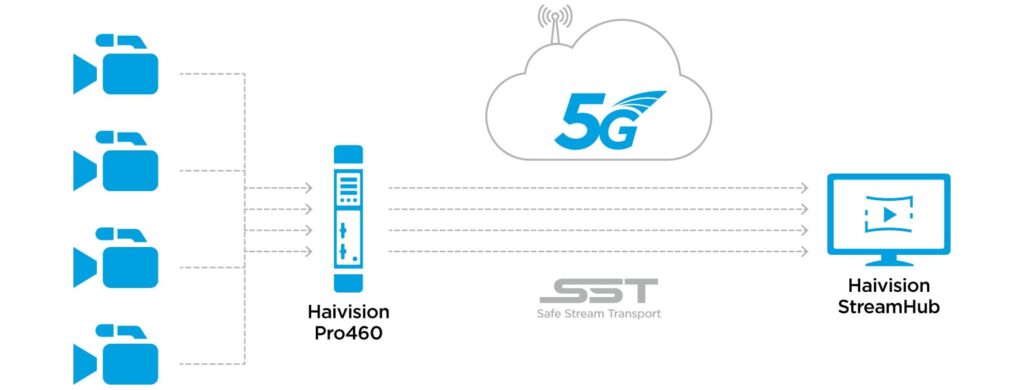What is Remote Production?
Remote production, sometimes referred to as the Remote Integration Model (REMI), or at-home production, is a broadcast workflow where content is captured live at a remote location while production is performed at a central location, on-premise or in the cloud. Remote production is typically used for sports or other live events, where having a full production suite on-location is not reasonable. According to the 2025 Haivision Broadcast Transformation Report, 43% of respondents said that enabling remote production is their organization’s top priority.
When it comes to the contribution of live video into these remote production workflows, the “first mile” of the workflow is essential as broadcasters get the live video from the cameras into their productions. In the past, teams needed to use expensive equipment such as OB (outside broadcast) vans and satellite uplinks to send live video and audio feeds back to the studio. But as more venues have become equipped with broadband connections and broadcasters are now increasingly using cellular networks, the necessary infrastructure for live video contribution has changed.
Today, broadcasters have a few options on how to transport the video: wired IP networks, cellular bonded networks, or a hybrid of both.
Wired IP video workflows for remote production rely on a physical network connection, like Ethernet, to transmit video over the internet. Video that is sent using a wired IP network is streamed live or recorded for use in post-production. Leveraging a wired IP connection enables consistent, low latency transmission that is optimal for fixed location shoots and cameras that don’t require mobility.
Remote production workflows are also powered by video over bonded cellular connections. By combining signals from different types of networks, like 4G or 5G, users can stream live video from remote locations without a physical network connection. This kind of workflow gives broadcasters the flexibility to easily go live from any location.
Remote teams can contribute high-quality video from nearly anywhere, even when the network conditions are unstable and unpredictable. Broadcasters using bonded cellular workflows for remote production aren’t confined to the physical limitations that come with using a wired IP connection and it allows for mobility when covering live events of any size.
A hybrid workflow combines both wired IP and bonded cellular connections, allowing for production teams to be flexible, maintain consistent video quality, and enables uninterrupted video delivery even when the network is unstable. With a hybrid model, broadcasters can seamlessly switch between both wired IP and bonded cellular connections which improves reliability and flexibility.
What are the Benefits of Remote Production?
Reduce Costs and Complexity
Deploying OB trucks and on-site production equipment is an expensive proposition requiring significant investment in logistical planning, video hardware, and support personnel. In addition, set up times are long, and there are many moving parts to contend with, allocating, transporting, and setting up equipment, securing and provisioning satellite links, as well as coordinating staff schedules, travel, and hotel arrangements. By eliminating the costly and complex coordination associated with deploying OB trucks full of expensive equipment and on-site production teams there are substantial time and cost-savings to be made.
Maximize Resources
With fewer people deployed in the field, broadcasters can instead focus on optimizing the use of their existing resources to produce more high-quality content. Remote production allows broadcasters to leverage their best operators, editors, and onscreen talent to work on multiple events with greater attention to consistency and quality. For example, a replay operator on-site at a sporting event might be only utilized for three hours during a four-day period. If the replay operator is at home, however, they could be running replays around the world, all the time.
Decentralize Production
Emerging technologies have enabled broadcasters to decentralize their production workflows to include multiple production locations as well as remote staff. Low latency IP streaming, including over the internet with SRT, or over cellular networks with SST, provides access to live production streams from anywhere. This can also include bi-directional streams for live interviews with remote subjects and talent. Executives and other staff can also access low latency streams to monitor live production from a laptop or mobile device using an encrypted connection to a cloud or on-premise stream gateway.
Create more content
When it comes to live content, customers want more choice and they’re willing to pay for it, particularly live sporting events which remain a huge draw. And this demand is not limited to just high-profile, traditional sports leagues, but college sports, niche sports, and even e-sports. The challenge with these events has been that deploying resources on-site is simply cost-prohibitive. By harnessing the latest video technologies designed for remote production, broadcasters can expand their coverage to meet demand while keeping production costs in check.
Remote production over the internet not only enables broadcasters to reach audiences with niche content, but it also allows them to increase coverage of a major event by using more feeds from multiple cameras around a venue. Fan-cams in the bleachers to player or bench cams, streams overlaid with real-time stats to video with bespoke commentary give the viewer more personalized viewing options and the video service provider great potential for targeted advertising.
How does Remote Production Work?
The workflow diagram below shows an example of what a basic remote contribution workflow from a sports venue might look like. In this workflow, there are four cameras, each with a mobile video transmitter connected to them , sending the video streams using the SST streaming protocol over a 5G cellular network , through to a receiver at the production studio, where the production team can then switch between camera angles and prepare the footage to be distributed to viewers.

There are, of course, many variations of this workflow, depending on what the live video is being used for. But in each workflow, using the right tools will ensure that your video feeds are synchronized, live video will arrive with low latency and high quality, and that your video streams will be secure from unauthorized users.
Haivision Solutions for Remote Production
For a remote production approach to be both successful and sustainable, broadcasters must be able to capture all the live action without compromising on quality to deliver the best possible experience to viewers. There have been justifiable concerns that have made some video providers reluctant to commit to this path. These concerns include connectivity and reliability, synchronization, latency, and security.
Aimed at addressing these challenges, Haivision offers a range of cost-effective, reliable, and secure video solutions for flexible IP and cloud-enabled broadcast workflows. From video encoders and decoders, to cellular video transmitters, field units, receivers, and video transport protocols, broadcasters around the globe rely on Haivision solutions to deliver ultra-low latency, flawless video with rock-solid reliability. Customers producing events like the TCS New York City Marathon, Sports Fishing Championship, and the Courchevel Ski Mountaineering Sprint trust and depend upon Haivision’s next-generation technologies to power their remote production workflows.
Future is Remote
However the future unfolds, it’s clear that the benefits of decentralized remote production over IP networks (both wired and cellular) have been greatly amplified by recent events. The advantages of IP and internet video streaming for remote production include more than just cost efficiencies, but also the potential for broadcasters to innovate with new ways to create and consume content. More broadcast professionals are working remotely, either in the field, in a central broadcast production facility, or at home and this trend is likely to continue as broadcasters realize the benefits of reducing costs and increasing efficiencies.
Decentralized production offers the flexibility for broadcast engineers and producers to work together in real-time to create and deliver more high-quality events. With the near ubiquity of high bandwidth internet and the availability of 5G cellular networks, live video streams for remote production can be shared in real-time from anywhere.
As broadcast facilities deploy SMPTE 2110, entire broadcast workflows will be IP enabled over both public and private networks. Furthermore, remote production workflows encompass a mix of on-premise and cloud-based elements for video encoding, decoding, and video processing, all accessible via IP networks. Technologies such as SRT can ensure low latency streaming, reliability, and security for decentralized remote production workflows while 5G is bringing viewers closer to the action. The potential for remote production over IP is limitless.

